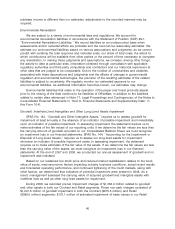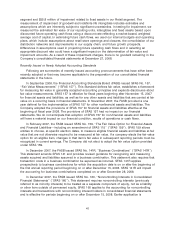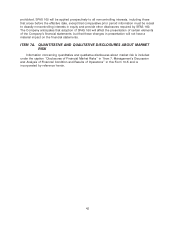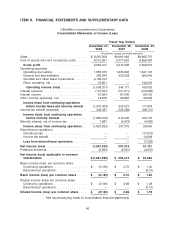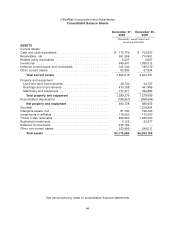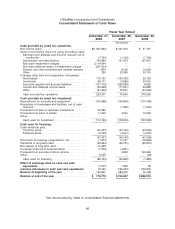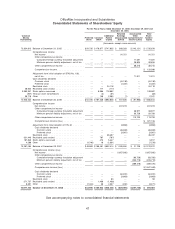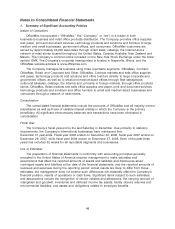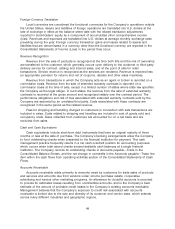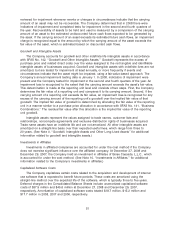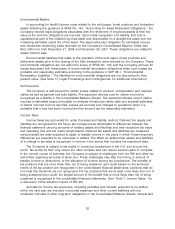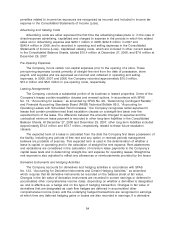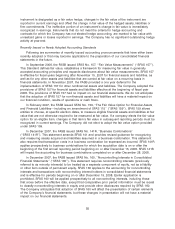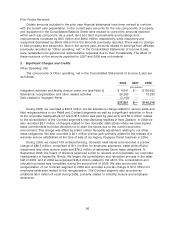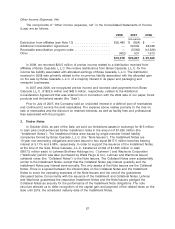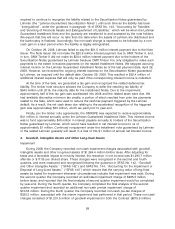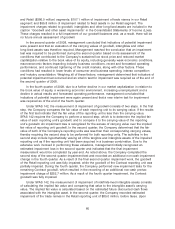OfficeMax 2008 Annual Report Download - page 54
Download and view the complete annual report
Please find page 54 of the 2008 OfficeMax annual report below. You can navigate through the pages in the report by either clicking on the pages listed below, or by using the keyword search tool below to find specific information within the annual report.The Company has an agreement with a third-party service provider that manages the
Company’s private label credit card program and directly extends credit to customers. We are
currently attempting to restructure our private label credit card program as the current card program
terminates on May 31, 2009. A new program may not be done on terms acceptable to us, or at all.
At December 27, 2008 and December 29, 2007, the Company had allowances for doubtful
accounts of $11.2 million and $14.5 million, respectively.
Vendor Rebates and Allowances
The Company participates in various cooperative advertising and other marketing programs
with its vendors. The Company also participates in volume purchase rebate programs, some of
which provide for tiered rebates based on defined levels of purchase volume. These arrangements
enable the Company to receive reimbursement for costs incurred to promote the sale of vendor
products, or to earn rebates that reduce the cost of merchandise purchased. Vendor rebates and
allowances are accrued as earned. Rebates and allowances received as a result of attaining defined
purchase levels are accrued over the incentive period based on the terms of the vendor
arrangement and estimates of qualifying purchases during the rebate program period. These
estimates are reviewed on a quarterly basis and adjusted for changes in anticipated product sales
and expected purchase levels. Volume-based rebates and allowances earned are initially recorded
as a reduction in the cost of merchandise inventories and are included in operations (as a
reduction in cost of goods sold) in the period the related product is sold. Amounts received under
other promotional programs are generally event-based and are recognized at the time of the event
as a reduction of cost of goods sold or inventory, as appropriate, based on the nature of the
promotion and the terms of the vendor agreement. Advertising and other allowances that represent
reimbursements of specific, incremental and identifiable costs incurred to promote vendors’
products are recorded as a reduction of operating and selling expenses in the period the expense
is incurred.
Merchandise Inventories
Inventories consist of office products merchandise and are stated at the lower of weighted
average cost or net realizable value. The Company estimates the realizable value of inventory using
assumptions about future demand, market conditions and product obsolescence. If the estimated
realizable value is less than cost, the inventory value is reduced to its estimated realizable value.
Throughout the year, the Company performs physical inventory counts at all locations. For
periods subsequent to each location’s last physical inventory count, an allowance for estimated
shrinkage is provided based on historical shrink results and current business trends.
Property and Equipment
Property and equipment are recorded at cost. The Company calculates depreciation using the
straight-line method over the estimated useful lives of the assets or the terms of the related leases.
The estimated useful lives of depreciable assets are generally as follows: building and
improvements, 5 to 40 years; furniture and equipment, 1.5 to 5 years; and machinery, equipment
and delivery trucks, 5 to 10 years. Leasehold improvements are amortized over the lesser of the
term of the lease, including any option periods that management believes are probable of exercise,
or the estimated lives of the improvements, which generally range from 5 to 15 years.
Long-Lived Asset Impairment
In accordance with Statement of Financial Accounting Standards (SFAS) No. 144, ‘‘Accounting
for the Impairment or Disposal of Long-Lived Assets,’’ long-lived assets, such as property, plant,
and equipment, capitalized software costs and purchased intangibles subject to amortization, are
50


